1993 CHEVROLET ASTRO PASSENGER fog light
[x] Cancel search: fog lightPage 11 of 345
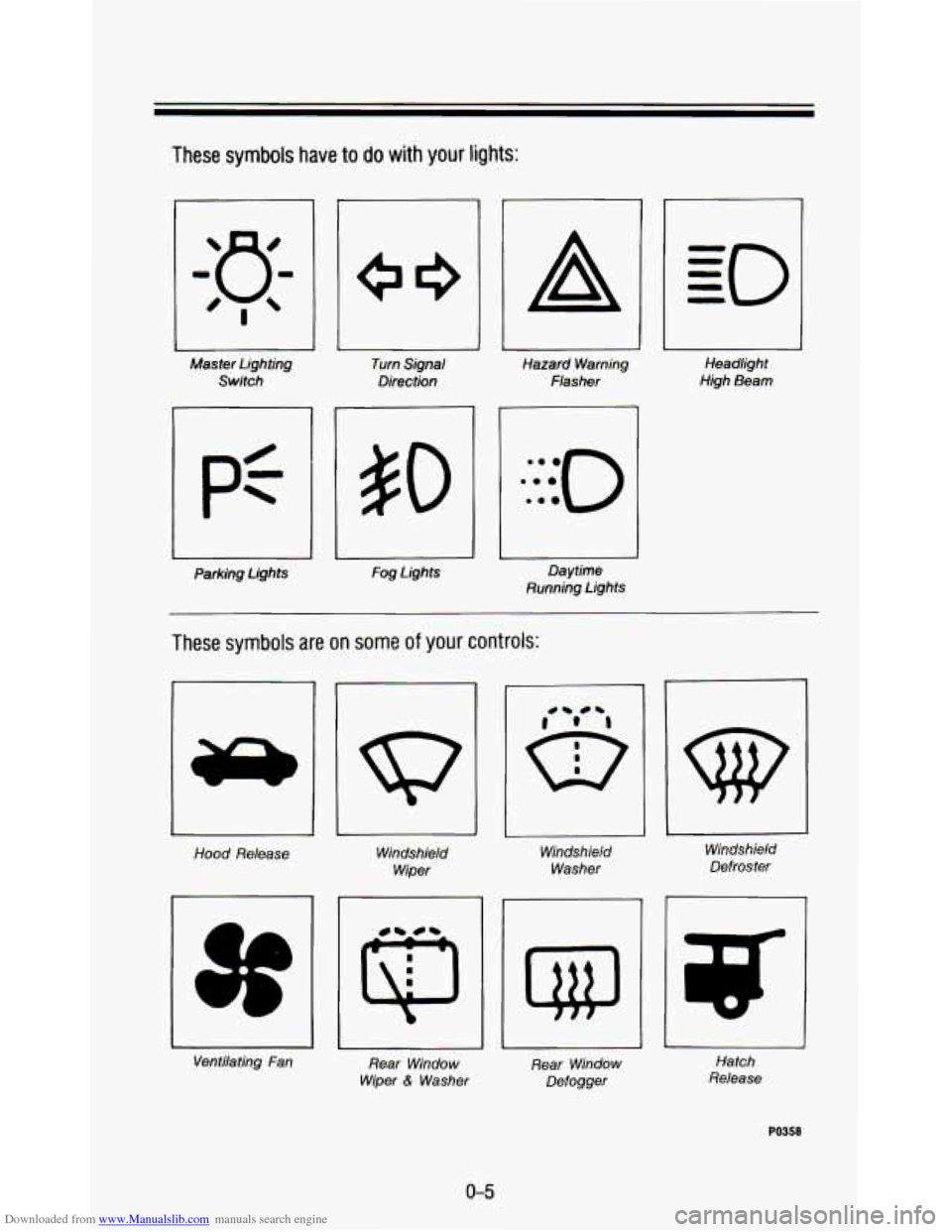
Downloaded from www.Manualslib.com manuals search engine These symbols have to do with your lights:
0
Master Lighting
Switch Turn
Signal
Direction
Parking Lights
Fog Lights
A
Hazard Warning
Flasher
Daytime
Running Lights Headlight
High Beam
~
These symbols are on some of your controls:
Hood Release Windshield
Wper
Ventilating Fan Windshield
Washer Windshield
Defroster
Rear Window
Wiper
L? Washer Rear Window
Defogger Hatch
Release
PO358
0-5
Page 87 of 345

Downloaded from www.Manualslib.com manuals search engine Operation of Lights
Although your vehicle's lighting system (headlights, parking lig\
hts, fog lamps,
side marker lights and tail lights) meet all applicable Federal lighting
requirements, certain states and provinces may apply their own \
lighting
regulations that may require special attention before you operate these lights.
For example, some jurisdictions may require that you operate yo\
ur lower
beam lights with fog lamps at all times, or that headlights be turned on
whenever you must use your windshield wipers. In addition, most jurisdictions
prohibit driving solely with parking lights, especially at dawn or dusk.
It is
recommended that you check with your own state or provincial h\
ighway
authority for applicable lighting regulations.
Headlight High-Low Beam
I
PO433
To change the headlights from low beam to high or high to low, pull the turn
signal lever all the way toward you. Then release
it. When the high beams
are on, a blue light on the instrument panel also will be on\
.
2-31
Page 98 of 345
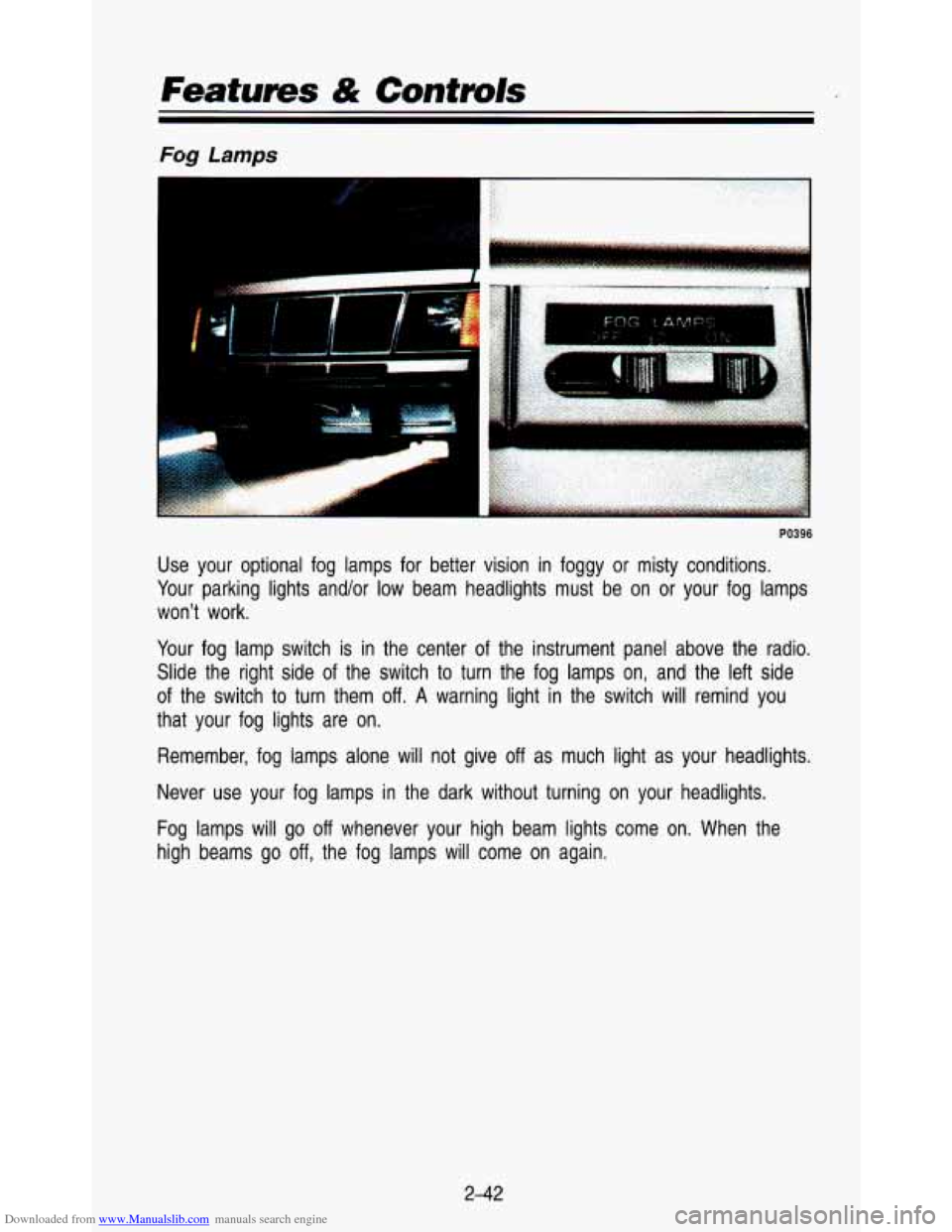
Downloaded from www.Manualslib.com manuals search engine Features & Contmls
PO396
Use your optional fog lamps for better vision in foggy or misty conditions.
Your parking lights and/or low beam headlights must be on or your fog lamps
won't work.
Your fog lamp switch
is in the center of the instrument panel above the radio.
Slide the right side
of the switch to turn the fog lamps on, and the left side
of the switch to turn them
off. A warning light in the switch will remind you
that your fog lights are
on.
Remember, fog lamps alone will not give off as much light as your headlights.
Never use your fog lamps in the dark without turning on your headlights.
Fog lamps will go
off whenever your high beam lights come on. When the
high beams go
off, the fog lamps will come on again.
2-42
Page 132 of 345

Downloaded from www.Manualslib.com manuals search engine Comfort Contmls & Audio Systems
Rear Air Conditioning
You may have rear air conditioning. The rear air conditioning switch is loca\
ted
above the radio at the top of the instrument panel. Slide the lever toward
HI
for cooler air in the rear area. Slide the lever to OFF to turn the system off.
If your vehicle has rear air conditioning, setting it on LOW may enhance front
NC performance by allowing trapped refrigerant in rear lines to circulate.
The system
will only send cooled air if the front system is on. It can still be
used
to recirculate air, even if the front system is off.
Before using the rear air conditioning, open the windows to cl\
ear the vehicle
of hot air. Close the windows when using the system.
Rear Window Defogger
HATCH REL REAR DEFOG
If your vehicle has this option the rear window will have lines \
running across
the glass. These lines heat your window.
For best results, clear the window of as much snow and ice as possible
before using the rear window defogger.
To turn on the rear window defogger, find the switch marked
Rear Defog on
your instrument panel to the left of the steering column. Press the top of the
switch until the light in the switch comes on, then release it. The rear window
defogger will only work when the ignition is in the
RUN position.
You can turn the defogger
off at any time by pressing the bottom of the
switch. The defogger will shut itself
off after several minutes so that the glass
3-8
Page 182 of 345
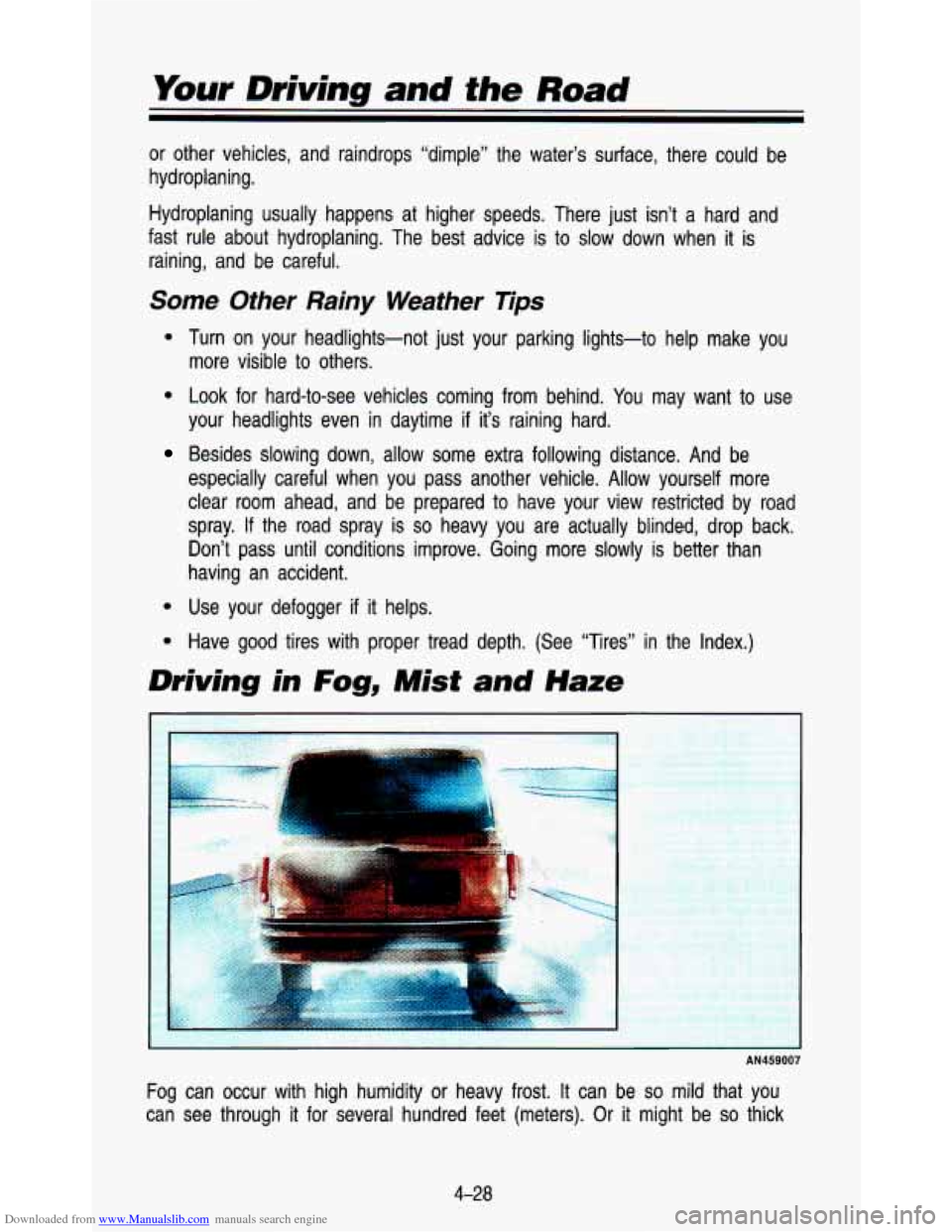
Downloaded from www.Manualslib.com manuals search engine Your Driving and the Road
or other vehicles, and raindrops “dimple” the water’s s\
urface, there could be
hydroplaning. Hydroplaning usually happens at higher speeds. There just isn’\
t a hard and
fast rule about hydroplaning. The best advice
is to slow down when it is
raining, and be careful.
Some Other Rainy Weather Tips
Turn on your headlights-not just your parking lights-to help ma\
ke you more visible
to others.
Look for hard-to-see vehicles coming from behind. You may want to use
your headlights even
in daytime if it’s raining hard.
Besides slowing down, allow some extra following distance. And \
be
especially careful when you pass another vehicle. Allow yourself\
more
clear room ahead, and be prepared
to have your view restricted by road
spray.
If the road spray is so heavy you are actually blinded, drop back.
Don’t pass until conditions improve. Going more slowly is be\
tter than
having an accident.
Use your defogger
if it helps.
Have good tires with proper tread depth. (See “Tires” in\
the Index.)
Driving in Fog, Mist and Haze
I ~
AN459007
Fog can occur with high humidity or heavy frost. It can be so mild that you
can see through
it for several hundred feet (meters). Or it might be so thick
4-28
Page 183 of 345
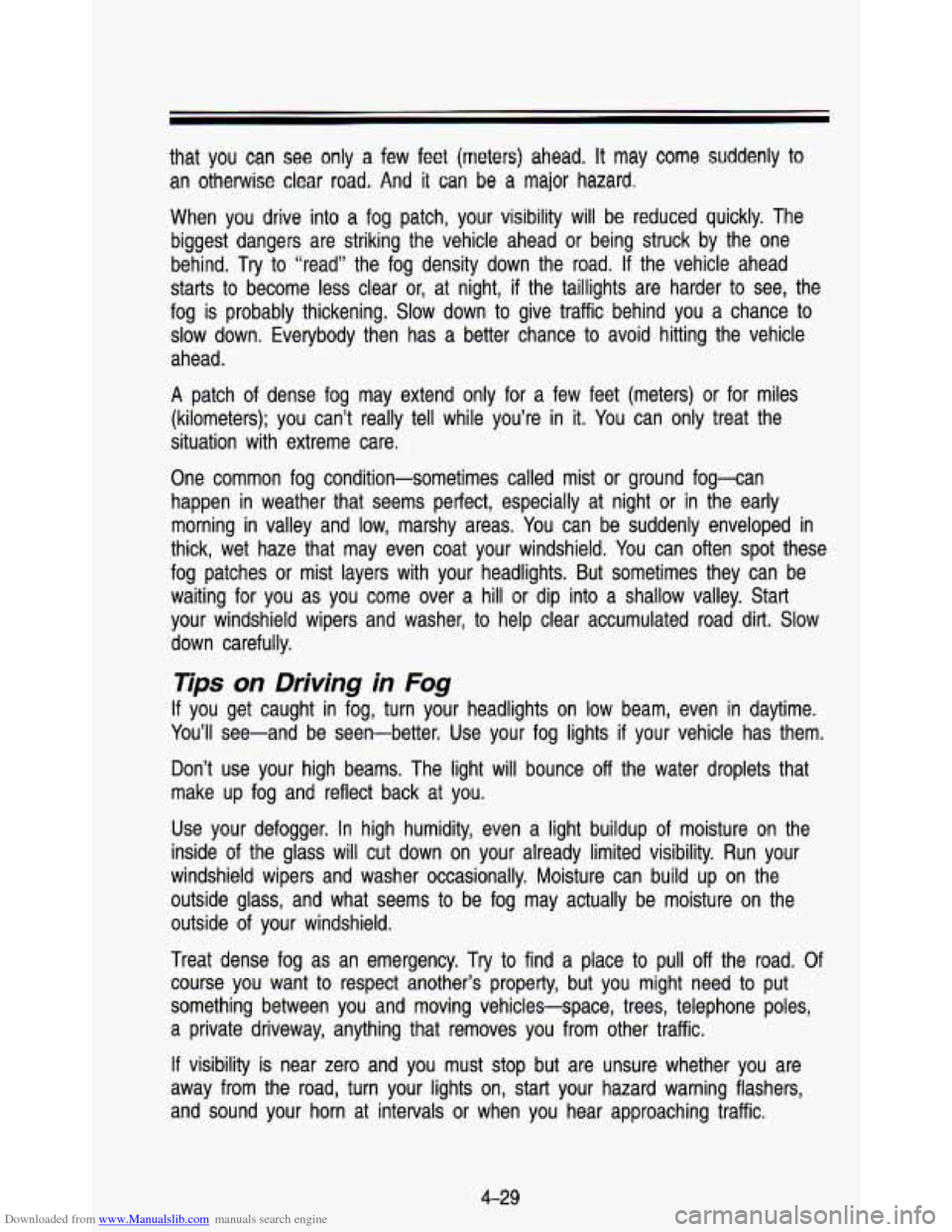
Downloaded from www.Manualslib.com manuals search engine that you can see only a few feet (meters) ahead. It may come suddenly to
an otherwise clear road. And it can be a major hazard.
When you drive into a fog patch, your visibility will be ieduced quickly. The
biggest dangers are striking the vehicle ahead
or being struck by the one
behind. Try
to “read” the fog density down the road. If the vehicle ahead
starts
to become less clear or, at night, if the taillights are harder to see, the
fog is probably thickening. Slow down to give traffic behind y\
ou a chance
to
slow down. Everybody then has a better chance to avoid hitting the vehicle
ahead.
A patch of dense fog may extend only for a few feet (meters) or for miles
(kilometers); you can’t really tell while you’re in
it. You can only treat the
situation with extreme care.
One common fog condition-sometimes called mist
or ground fog-can
happen in weather that seems perfect, especially at night
or in the early
morning in valley and low, marshy areas. You can be suddenly enveloped in
thick, wet haze that may even coat your windshield. You can often spot these
fog patches
or mist layers with your headlights. But sometimes they can be
waiting for you as you come over a hill
or dip into a shallow valley. Start
your windshield wipers and washer,
to help clear accumulated road dirt. Slow
down carefully.
Tips on Driving in Fog
If you get caught in fog, turn your headlights on low beam, even\
in daytime.
You’ll see-and be seen-better. Use your fog lights
if your vehicle has them.
Don’t use your high beams. The light will bounce
off the water droplets that
make up fog and reflect back at you.
Use your defogger. In high humidity, even a light buildup of moisture on the
inside
of the glass will cut down on your already limited visibility. Ru\
n your
windshield wipers and washer occasionally. Moisture can build up\
on the outside glass, and what seems to be fog may actually be moist\
ure on the
outside of your windshield.
Treat dense fog as an emergency.
Try to find a place to pull off the road. Of
course you want
to respect another’s property, but you might need to put
something between you and moving vehicles-space, trees, telephone poles,
a private driveway, anything that removes you from other traffi\
c.
If visibility is near zero and you must stop but are unsure whether you are
away from the road, turn your lights on, start your hazard warning flashers,
and sound your horn at intervals
or when you hear approaching traffic.
4-29
Page 184 of 345
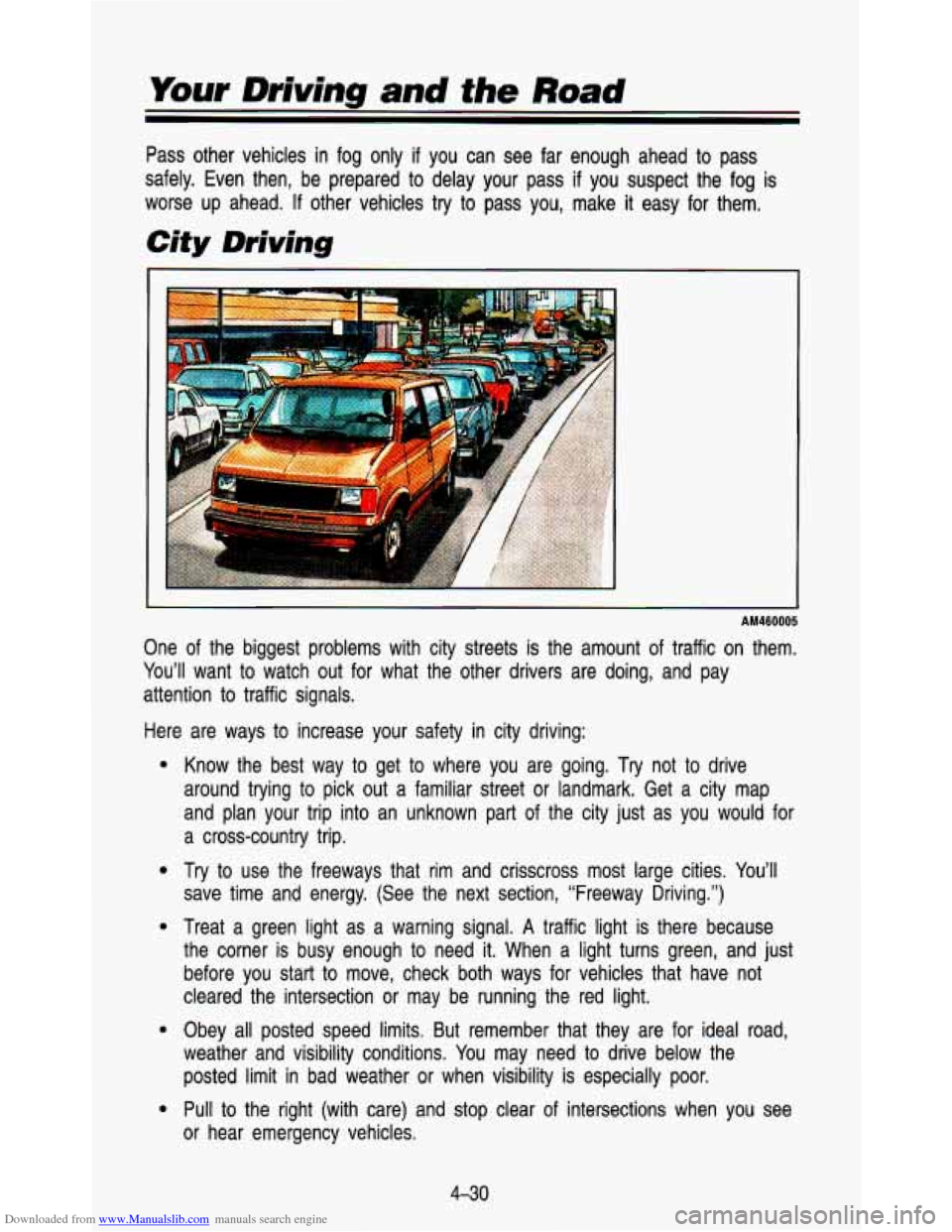
Downloaded from www.Manualslib.com manuals search engine Your Driving and the Road
Pass other vehicles in fog only if you can see far enough ahead to pass
safely. Even then, be prepared to delay your pass
if you suspect the fog is
worse up ahead.
If other vehicles try to pass you, make it easy for them.
City Driving
AM460005
One of the biggest problems with city streets is the amount of traffic on them.
You’ll want to watch out for what the other drivers are doing, and pay
attention to traffic signals.
Here are ways to increase your safety in city driving:
e
e
e
e
Know the best way to get to where you are going. Try not to drive
around trying to pick out a familiar street or landmark. Get \
a city map
and plan your trip into an unknown part of the city just as you would for
a cross-county trip.
Try to use the freeways that rim and crisscross most large cities. You’ll
save time and energy. (See the next section, “Freeway Drivi\
ng.”)
Treat a green light as a warning signal.
A traffic light is there because
the corner is busy enough to need
it. When a light turns green, and just
before you start to move, check both ways for vehicles that have not
cleared the intersection or may be running the red light.
Obey all posted speed limits. But remember that they are for ideal road,
weather and visibility conditions. You may need to drive below the
posted limit in bad weather
or when visibility is especially poor.
Pull to the right (with care) and stop clear of intersections when y\
ou see
or hear emergency vehicles.
430
Page 304 of 345

Downloaded from www.Manualslib.com manuals search engine Service & Appearance Care
Fuses and Circuit Breakers Usage
Name
Inst. Lps.
Pwr. Acc.
Horn-Dm.
Gages
Aux. Htr. NC
Stop-Haz.
Tail Lps.
Turn
BIU
Htr. NC
Radio
ECM B
ECM
I
Pwr. Wdo.
Wiper
Brake
Fog Lamps***
DRL**
Pow. Mirrors*
Trailer*
Circuits Protected
Instrument Panel Lamps, Radio Dial
Lamps, Heater Lamps
Power Door Locks, Power Seat
Horn Relay, Digital Clock, Cigarette
Lighter, Dome Lights, Radio Memory,
Glove Box Lamp
Instrument Cluster Gages, Brake
Switch, Audio Alarm, Headlight Switch
Illumination, Ash Tray Illumination,
Cruise Control
Auxiliary Heater-Rear NC
(if equipped)
Stop Lamps, Hazard Flash, Digital
Instrument Cluster
Headlamp Switch, Tail and Parking
Lamps
Direction Signal Flash, Back Up
Lamps
Front Heater
& Air Conditioning
Radio
Engine Control Module
Engine Control Module
Power Windows
Windshield Wiper
Anti-Lock Brake System,
Speedometer
Fog Lamps
Canadian Daytime Running Lights
Power Mirror
Trailer Wirina Harness
Fuse
10 Amp
30 Amp
20 Amp
25 Amp
20 Amp
20 Amp
20 Amp
20 Amp
10 Amp
10 Amp
10 Amp
25 Amp
15 Amp
15 Amp
10 Amp
3 Amp
30 Amr,
Circuit
Breaker
30 Amp
30 Amp
*In-line fuse.
**Canada only.
“*In-line fuse (certain models).
TO007
6-68